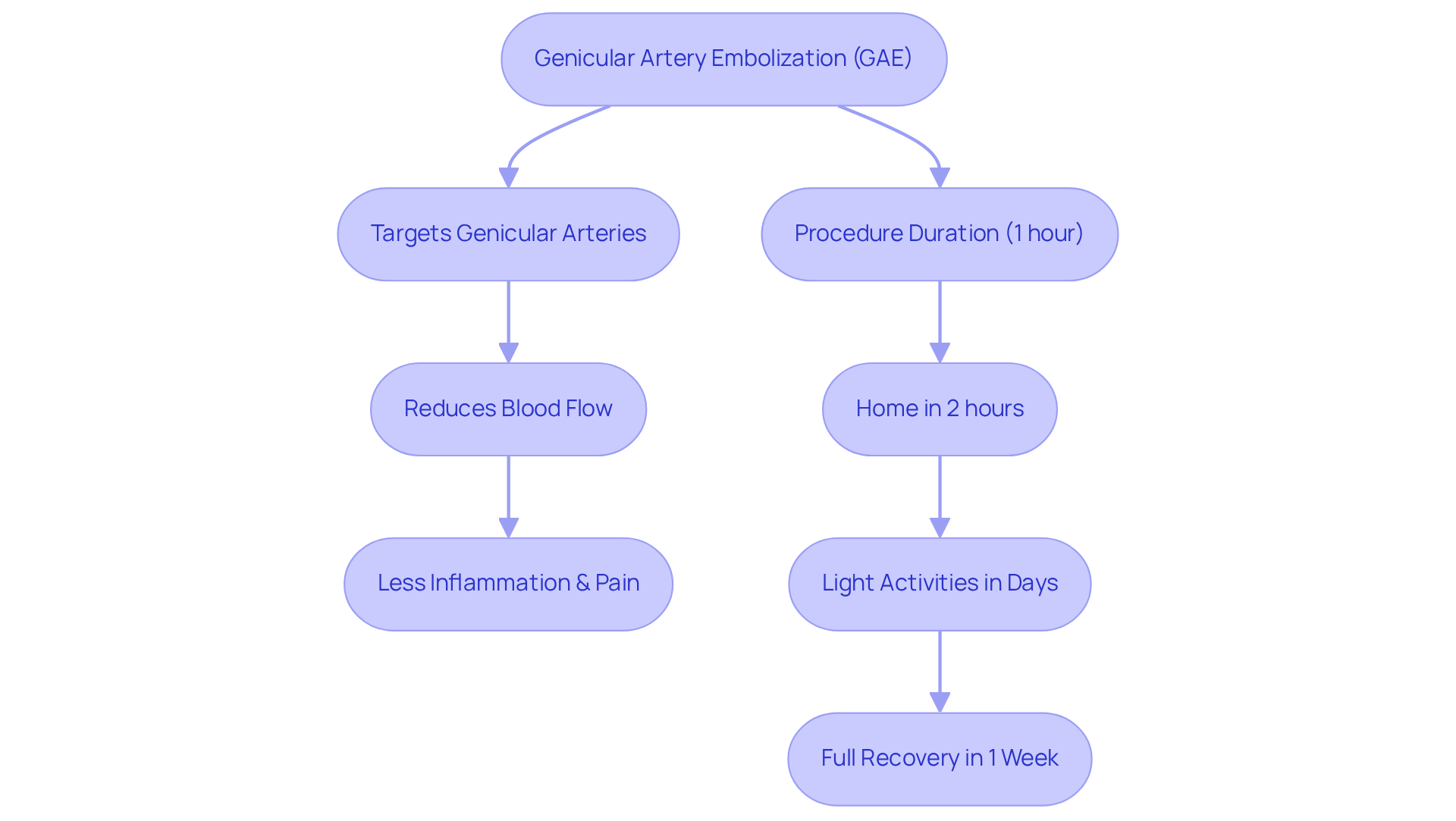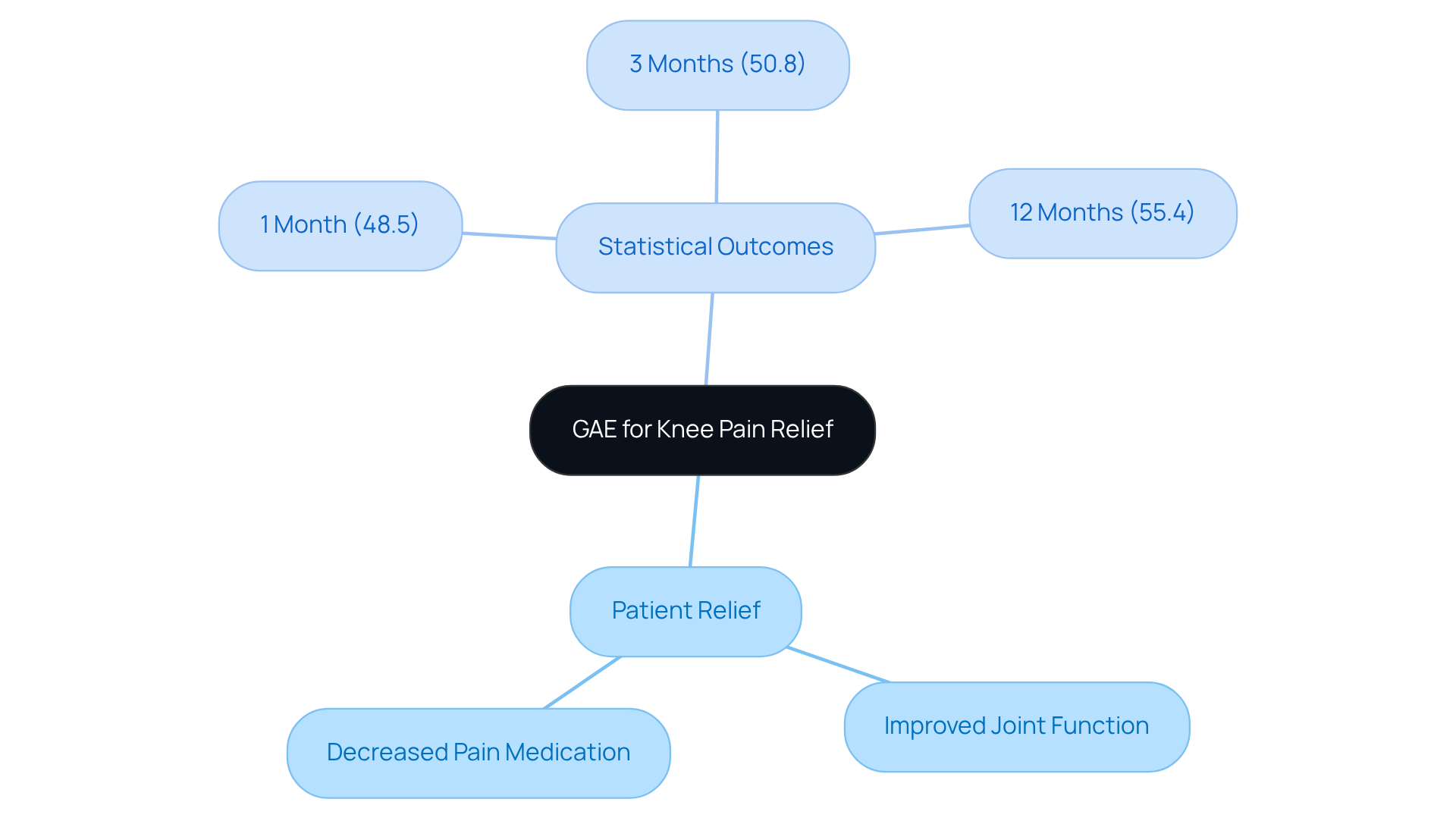


Are you or a loved one struggling with knee pain? If traditional treatments haven’t brought relief, you might feel frustrated and uncertain about your options. Genicular Artery Embolization (GAE) could be a gentle, minimally invasive solution worth considering. This innovative approach has shown remarkable results, especially for individuals with osteoarthritis, with up to 85% experiencing significant pain reduction that can last from one to three years.
Clinical outcomes reveal substantial decreases in pain scores and improved joint function, making GAE a promising alternative to more invasive procedures. Imagine regaining the ability to enjoy daily activities without the burden of constant pain. In addition to this, many patients have shared their positive experiences, expressing relief and gratitude for the newfound comfort in their lives.
If you’re feeling hesitant or anxious about your health, know that you’re not alone. It’s completely natural to have concerns, but reaching out for support can be the first step toward relief. We’re here to help guide you through your options and provide the compassionate care you deserve. Don’t hesitate to ask questions or seek further information; your well-being is our priority.
Genicular Artery Embolization (GAE) is emerging as a groundbreaking solution for individuals grappling with knee pain, especially those affected by osteoarthritis. If you’ve been struggling with chronic discomfort, this minimally invasive procedure might offer you a much-needed respite. It presents a viable alternative for patients who have exhausted traditional treatment options, providing hope where there may have been little before.
However, as GAE gains recognition for its effectiveness, it’s natural to have questions about its clinical outcomes, costs, and insurance coverage. Is GAE the key to a pain-free life for those in need? Or are there hurdles that patients must navigate to access this innovative treatment? These are important considerations, and it’s essential to explore them together.
At the heart of this discussion is your well-being. Understanding your options can empower you to make informed decisions about your health. If you’re feeling uncertain or anxious, know that you’re not alone. Many patients share similar concerns, and seeking support can make a world of difference.
In addition to this, it’s crucial to remember that there are compassionate healthcare professionals ready to guide you through this journey. They can help clarify any doubts and provide the reassurance you need. So, if you’re ready to take the next step towards relief, don’t hesitate to reach out for help. Your path to a more comfortable life may be closer than you think.
Genicular Artery Embolization (GAE) is a remarkable, minimally invasive technique that aims to ease chronic discomfort, particularly for those suffering from osteoarthritis, which affects around 5 million people. If you’ve been struggling with knee pain, you might find comfort in knowing that this procedure targets the genicular arteries, the vessels that supply blood to your knee joint. By carefully blocking these arteries, GAE can significantly reduce blood flow to inflamed tissues, leading to less inflammation and pain.
This procedure is especially helpful for individuals who haven’t found relief through traditional treatments like physical therapy or medication. Conducted with precise imaging guidance, GAE prioritizes your safety and accuracy, making it a reassuring non-surgical option for those seeking effective pain relief. The procedure typically lasts about an hour, and most patients can return home just a couple of hours afterward. Light activities can often be resumed within days, with a full return to normal life in about a week.
As Dr. Tessa Balach, an orthopaedic surgeon, wisely notes, "But I believe GAE may be a great option for those who aren’t prepared for a joint replacement yet." It’s important to remember that serious complications from GAE are rare when performed by skilled interventional radiologists, highlighting the safety of this innovative approach. If you’re feeling uncertain about your options, know that support is available, and GAE might just be the solution you’ve been looking for.

If you're struggling with joint discomfort, you're not alone. Clinical studies have shown that Genicular Artery Embolization (GAE) can be a promising remedy for many individuals like you. In fact, up to 85% of patients report significant relief from discomfort lasting between one to three years after the procedure.
For example, a study involving 40 individuals suffering from moderate to severe discomfort due to osteoarthritis found a mean reduction in discomfort scores of:
It's important to note that all participants in this study were not suitable candidates for joint replacement surgery, highlighting GAE as a viable option for those seeking alternatives to more invasive procedures.
Many individuals also reported improved joint function and a decreased reliance on pain medications after undergoing GAE. Dr. Daniel Alterman describes GAE as a "game-changer for individuals with chronic joint discomfort," emphasizing its ability to provide significant and lasting relief.
These findings underscore GAE's potential to help those suffering from knee osteoarthritis, especially for individuals who may not be candidates for more invasive surgical interventions. Plus, GAE is a minimally invasive procedure that requires no surgical incisions, allowing you to return home the same day. This aspect makes it even more appealing for those looking for effective relief without the stress of a lengthy recovery.
If you're considering options for your joint discomfort, GAE might be worth discussing with your healthcare provider. Remember, you deserve to feel comfortable and supported in your journey towards better health.

Understanding the gae outcomes cost associated with Genicular Artery Embolization (GAE) can be a concern for many. Typically, the gae outcomes cost ranges from $5,000 to $15,000, influenced by factors such as the healthcare provider, geographical location, and individual needs. This price usually covers the procedure fee, necessary imaging, embolic materials, and follow-up care.
Patients often find that they can return to light activities within days after GAE, with a full return to normalcy in about a week. This quick recovery highlights the procedure's benefits, offering hope for those struggling with joint pain.
As insurance coverage for GAE evolves, it’s important to note that some private insurers may provide coverage, while others might require preauthorization or additional documentation to establish medical necessity. Have you already tried conservative treatments like medications and physical therapy? It’s essential to have explored these options before considering GAE.
We encourage you to reach out to your insurance provider to clarify coverage details and any potential out-of-pocket expenses. Understanding these financial factors is crucial for making informed decisions regarding the gae outcomes cost of your treatment options. Recent case studies emphasize the importance of managing insurance processes effectively, ensuring that individuals can secure the necessary coverage for GAE as a viable alternative to joint replacement surgery.
Expert insights from Dr. Albert Chun and Dr. Rodeen Rahbar, both seasoned in interventional procedures, suggest that demonstrating medical necessity through prior conservative treatments and imaging studies can significantly improve the chances of insurance approval. Furthermore, if symptoms recur, GAE can be repeated, offering a flexible approach to managing joint discomfort.
As trends in insurance coverage for minimally invasive knee pain treatments continue to develop, it’s vital for patients to remain proactive in exploring their options. This includes considering financial alternatives for those without insurance coverage. Remember, you’re not alone in this journey, and support is available to help you navigate your choices.

Genicular Artery Embolization (GAE) offers a compassionate solution for those dealing with chronic knee pain, especially individuals suffering from osteoarthritis. This minimally invasive procedure not only addresses the sources of inflammation but also provides hope for patients who haven’t found relief through traditional treatments. With its potential to significantly reduce discomfort and improve joint function, GAE presents a promising path to recovery without the need for invasive surgery.
Consider the encouraging insights from clinical studies:
If you’re struggling with knee pain, it’s important to explore GAE as a potential option on your journey to better health. Engaging with your healthcare provider about this procedure and discussing the associated costs and insurance coverage can empower you to make informed choices. Remember, the path to relief is within reach. With the right support and information, you can take confident steps toward reclaiming your quality of life.
What is Genicular Artery Embolization (GAE)?
Genicular Artery Embolization (GAE) is a minimally invasive technique designed to relieve chronic pain, particularly for individuals suffering from osteoarthritis in the knee.
How does GAE work?
GAE works by targeting the genicular arteries, which supply blood to the knee joint. By blocking these arteries, the procedure reduces blood flow to inflamed tissues, leading to decreased inflammation and pain.
Who can benefit from GAE?
GAE is especially beneficial for individuals who have not found relief through traditional treatments such as physical therapy or medication.
What is the duration of the GAE procedure?
The GAE procedure typically lasts about one hour.
What is the recovery time after GAE?
Most patients can return home a couple of hours after the procedure, resume light activities within days, and fully return to normal life in about a week.
Are there any serious complications associated with GAE?
Serious complications from GAE are rare when the procedure is performed by skilled interventional radiologists, indicating a high level of safety.
Is GAE a good option for those considering joint replacement?
Yes, GAE may be a great option for individuals who are not yet prepared for a joint replacement, as noted by Dr. Tessa Balach, an orthopaedic surgeon.